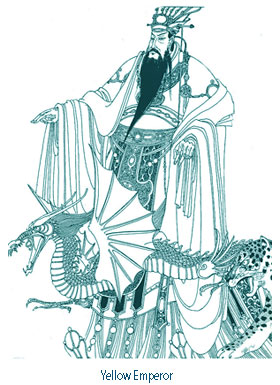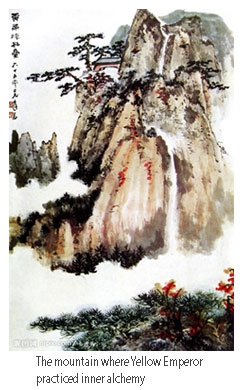TCM Theory: Yellow Emperor Inner Classic (Huangdi Neijing)
Source: Wikipeida
Contents:
1. Overview
2. Date of comparison
3. Wang Bin version
4. Authoritative version
5. Recent studies
6. Comparison and critique of English translations
7. External links
Overview
Huangdi Neijing, also known as The Inner Canon of Huangdi or Yellow Emperor’s Inner Canon, is an ancient Chinese medical text that has been treated as the fundamental doctrinal source for Chinese medicine for more than two millennia and until today. It is comparable in importance to the Hippocratic Corpus in Greek medicine or the works of Galen in Islamic and medieval European medicine. The work is composed of two texts each of eighty-one chapters or treatises in a question-and-answer format between the mythical Huangdi (Yellow Emperor or more correctly Yellow Thearch) and six of his equally legendary ministers.
The first text, the Suwen, also known as Basic Questions, covers the theoretical foundation of Chinese Medicine and its diagnostic methods. The second and generally less referred-to text, the Lingshu [Spiritual Pivot], discusses acupuncture therapy in great detail. Collectively, these two texts are known as the Neijing or Huangdi Neijing. In practice, however, the title Neijing often refers only to the more influential Suwen. Two other texts also carried the prefix Huangdi neijing in their titles: the Mingtang [“Hall of Light”] and the Taisu [“Grand Basis”], both of which have survived only partially.

 The earliest mention of the Huangdi neijing was in the bibliographical chapter of the Hanshu (or Book of Han, completed in 111 CE), next to a Huangdi waijing (“Yellow Emperor’s Outer Canon”) that is now lost. A scholar-physician called Huangfu Mi (215-282 CE) was the first to claim that the Huangdi neijing in 18 volumes that was listed in the Hanshu bibliography corresponded with two different books that circulated in his own time: the Suwen and the Zhenjing (Needling Canon), each in 9 juan. Since scholars believe that Zhenjing was one of the Lingshu’s earlier titles, they agree that the Han-dynasty Huangdi neijing was made of two different texts that are close in content to the works we know today as the Suwen and the Lingshu.
The earliest mention of the Huangdi neijing was in the bibliographical chapter of the Hanshu (or Book of Han, completed in 111 CE), next to a Huangdi waijing (“Yellow Emperor’s Outer Canon”) that is now lost. A scholar-physician called Huangfu Mi (215-282 CE) was the first to claim that the Huangdi neijing in 18 volumes that was listed in the Hanshu bibliography corresponded with two different books that circulated in his own time: the Suwen and the Zhenjing (Needling Canon), each in 9 juan. Since scholars believe that Zhenjing was one of the Lingshu’s earlier titles, they agree that the Han-dynasty Huangdi neijing was made of two different texts that are close in content to the works we know today as the Suwen and the Lingshu.
The Yellow Emperor’s Inner Classic (Huangdi Neijing) is the most important ancient text in Chinese medicine as well as a major book of Daoist theory and lifestyle. The text is structured as a dialogue between the Yellow Emperor and one of his ministers or physicians, most commonly Qíbó, but also Shàoyú. One possible reason for using this device was for the (anonymous) authors to avoid attribution and blame。
The Neijing departs from the old shamanistic beliefs that disease was caused by demonic influences. Instead the natural effects of diet, lifestyle, emotions, environment, and age are the reason diseases develop. According to the Neijing, the universe is composed of various forces and principles, such as Yin and Yang, Qi and the Five Elements (or phases). These forces can be understood via rational means and man can stay in balance or return to balance and health by understanding the laws of these natural forces. Man is a microcosm that mirrors the larger macrocosm. The principles of yin and yang, the five elements, the environmental factors of wind, damp, hot and cold and so on that are part of the macrocosm equally apply to the human microcosm.
Date of composition
Historian of science Nathan Sivin is of the opinion (1998) that the Suwen and Lingshu probably date to the 1st century BCE. He does not go into detail other than mentioning the Mawangdui excavations. Sivin (1998) is also of the opinion that “no available translation is reliable.”
In pages 89-90 of the book Celestial Lancets (first published in 1980), authored by the highly respected scholars Joseph Needham (1900-1995) and Lu Gwei-Djen (1904-1991), it states that the consensus of scholarly opinion is that the Suwen belongs to the second century BCE. They further state that evidence shows that the Suwen is earlier than the first of the pharmaceutical natural histories, the Shennong Bencao Jing (Divine Husbandman’s Classic of the Materia Medica). So suggestive are parallels with third and fourth century BCE literature that doubt arises as to whether the Suwen be better ascribed to the third century BCE, implying that certain portions of the Suwen may be of that date. The dominant role the theories of yin and yang and the five elements play in the physiology and pathology means that these medical theories are not older than about 320 BCE.
The German scholar Unschuld states several twentieth century scholars are of the opinion that the language and ideas of the Neijing Suwen were composed between 400 BCE and 260 CE. Further, versions existing today are a simply the last in a series of compilations and that none of the versions that exist today are identical to the texts of the same name from the Han Dynasty (206 BCE–220 CE) era.
Lü Fu, a fourteenth-century literary critic, was of the opinion that the Suwen was compiled by several authors over a long period. It contents were then brought together by Confucian scholars in the Han Dynasty era.
Scholars of excavated medical texts, Donald Harper, Vivienne Lo and Li Jianmin, agree that the systematic medical theory in the Neijing varies shows significant variance from texts found in the Mawangdui tomb (which was closed in 186 BCE). Because of this, they consider the Neijing to have been compiled after the Mawangdui texts.
Wang Bing version
In 762 CE, Wang Bing finished his revision of the Suwen after laboring for twelve years. Wang Bing collected the various versions and fragments of the Suwen and reorganized it into the present eighty-one chapters (treatises) format. (Note, treatises seventy-two and seventy-three are lost and only the titles are known.) Originally his changes were all done in red ink, but later copyists incorporated some of his additions into the main text. However, the 1053 version discussed below restored almost all of his annotations and they are now written in small characters next to the larger characters that comprise the main or unannotated Suwen text.
According to Unschuld (pages 39 and 62) Wang Bing’s version of the Suwen was based on Quan Yuanqi’s (early six century) commented version of the Suwen consisting of nine juan (books) and sixty-nine discourses. Wang Bing made corrections, added two “lost” discourses, added seven comprehensive discourses on the five phases and six qi, inserted over 5000 commentaries and reorganized the text into twenty-four juan (books) and eighty-one treatises.
In his preface to his version of the Suwen, Wang Bing goes into great detail listing the changes he made. Not much is known about Wang Bing’s life. He authored several books but is best known for his work on the Suwen. A note in the preface left by the later editors of the Chong Guang Bu Zhu Huangdi Neijing Suwen (version compiled by 1053 editorial committee) which was based on an entry in Tang Ren Wu Zhi (Record on Tang [Dynasty] Personalities) states that he was an official with the rank of tai pu ling and died after a long life of more than eighty years.
Authoritative version

 The “authoritative version” used today, Chong Guang Bu Zhu Huangdi Neijing Suwen is the product of the eleventh century Imperial Editorial Office (beginning in 1053 CE) and was based considerably on Wang Bing’s 762 CE version. Some of the leading scholars who worked on this version of the Suwen were Lin Yi, Sun Qi, Gao Baoheng and Sun Zhaotong.
The “authoritative version” used today, Chong Guang Bu Zhu Huangdi Neijing Suwen is the product of the eleventh century Imperial Editorial Office (beginning in 1053 CE) and was based considerably on Wang Bing’s 762 CE version. Some of the leading scholars who worked on this version of the Suwen were Lin Yi, Sun Qi, Gao Baoheng and Sun Zhaotong.
Recent studies
Recently (2003), the Chinese medicine history scholar Paul Unschuld, Hermann Tessenow and their team at the Institute for the History of Medicine at Munich University have translated the Neijing Suwen into English including, an analysis of the historical and structural layers of the Suwen. No publishing date has been given for this multi-volume work.
Significant portions of the above Suwen translation (but with only a fraction of the annotations) are currently available in Huang Di nei jing su wen: Nature, Knowledge, Imagery in an Ancient Chinese Medical Text.
Comparison and critique of English translations (partial list)
Note, none of following listed translations are perfect, they each vary in their interpretation of the text, but by comparing and combining individual translations a workable result can be obtained. The translations are organized below by type of translation. (Note, some of the translations listed are only partial translations.)
Sinological Translations
- Handbooks for Daoist Practice, translated by Louis Komjathy. Ten volume set of pamphlets, where volume three of the set is Yellow Thearch’s Basic Questions. Only the first two discourses out of the total eighty-one are translated. A technical translation, with a good introduction giving the history of the text and an explanation of some of the more of technical terminology present in the first two chapters. Credentials: Sinologist and Daoist scholar. He received his Ph.D. in religious studies from Boston University under Daoist scholar Livia Kohn.
TCM Style Translations
- The Medical Classic of the Yellow Emperor, translated by Zhu Ming, Foreign Language Press, Beijing, China, 2001, 302 pages. ISBN 7-119-02664-X. An edited version of the Neijing with the treatises reordered by topic. About a 20-25 percent of the Neijing (both Suwen and Lingshu) is translated. Includes annotations and commentaries by translator. Contains a Chinese-English glossary of important terms. Credentials: doctor of TCM from Hunan College of Traditional Chinese Medicine, plus many years of clinical practice.
- Yellow Empero’s Canon of Internal Medicine (stated to be Wang Bing’s version, but a quick examination shows it to appear to be identical to the authoritative version, but without the commentary), translated by Nelson Liansheng Wu and Andrew Qi Wu. China Science & Technology Press, Beijing, China, 1999, 831 pages. ISBN 7-5046-2231-1. Complete translation of both Suwen and Lingshu. Contains the Neijing text in simplified Chinese characters, along with alternate variants of Neijing text (also in simplified characters). The alternate variants of the Neijing are not translated, only the main version is translated. None of the commentary by Wang Bing is translated. Incorrectly translated in places along with additional “commentary” inserted into the translation, but not labeled as such. No notes. Credentials: unknown.
Medical History Translations
- Huang Di nei jing su wen: Nature, Knowledge, Imagery in an Ancient Chinese Medical Text, Unschuld, Paul U., 2003. University of California Press, Berkeley and Los Angeles, California. ISBN 0-520-23322-0. Analysis and history of the Suwen. Includes significant portions of the Suwen translated into English. Unusual terminology choices, such as the non standard translation of “ying qi” as “camp qi,” instead of the more commonly accepted “construction qi.” Instead of translating mai as “pulse,” Unschuld translates it as “[movement in the] vessels” or something similar. (Note, mai means both “vessels” and “the pulse.” By context one can tell if vessels or pulse is meant.) In treatise seventeen he translates qie mai dong jing as “squeeze the vessels, whether [their movement] is excited or quiet,” a more accurate translation would be “feel-closely the movement [and] the non-movement of the pulse.” Further, 動靜 is likely a polar binome and indicates the entire action, so a non literal, but more semantically correct translation would be “feel-closely the entirety of the pulse.” Credentials: sinologist and professor, head of the Institute for the History of Medicine at the Ludwig-Maximilian University of Munich.
- The Yellow Emperor’s Classic of Internal Medicine, translated by Ilza Veith. University of California Press, December, 2002, 288 pages. ISBN 0-520-22936-3. Translation of: (1) Wang Bing’s 762 CE preface, (2) the circa 1053 CE Imperial Office’s preface, (3) a historical account of the Huangdi Suwen from chapter 103 of the Siku Quanshu Zongmu Tiyao (Complete Library of the Four Treasuries: General Catalog with Abstracts) and (4) the first thirty-four chapters (treatises) of the Suwen. Includes an extensive introductory study with illustrations. The first published English translation of the Suwen. (Originally copyrighted in 1949.) Though a pioneering contribution, it is badly mistranslated in many places–read with caution and compare with other translations. Note, the 2002 edition compared to the 1966 edition has a new forward by Ken Rose and perhaps a few sentences were changed; essentially identical to the 1966 edition. Credentials: medical historian, who received her Ph.D. in the History of Medicine, by the Institute for the History of Medicine at Hopkins.
External links
- Online Neijing Suwen text in traditional characters (Big5 encoding). No details about text given, contains no notes or commentary. http://www.chinapage.com/big5/science/hw2.htm
- The Needham Research Institute, a centre for the study of the history of East Asian science, technology and medicine. http://www.nri.org.uk/
- Images of the Chong Guang Bu Zhu Huangdi Neijing Suwen printed in the Ming Dynasty (1368-1644 CE) by Gu Congde see http://wwww.tjutcm.edu.cn/www2/tulu/26.htm, note, the string “wwww” in the URL is not a typo.
- Review of Huang Di Nei Jing Su Wen: Nature, Knowledge and Imagery in an Ancient Chinese Medical Text by Louis Komjathy, Boston University, September 21, 2004. http://www.daoiststudies.org/review.unschuld.php
- “A brief overview of TCM in history and a chronology of important events and classic texts”. http://www.shen-nong.com/eng/history/zhou.html
OPENING HOURS
| Week Days | 8:00 – 5:00 |
| Saturday | 9:00 – 5:00 |
| Sunday | 11:00 – 4:00 |




